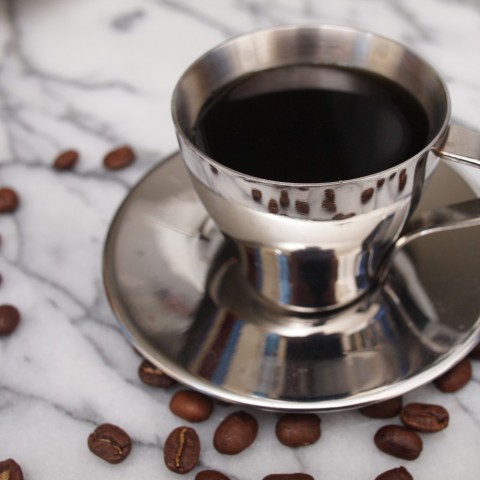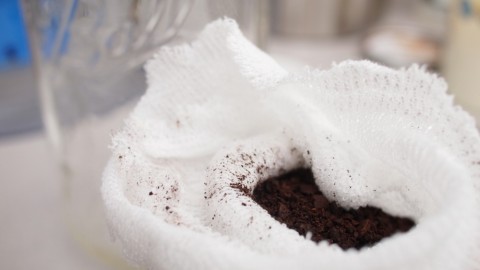This may be the shortest, simplest recipe that I’ve ever posted in this space. So short is it that I’ll give you all the ingredients right here: coffee, water, and time. So simple is it that I’d feel a little silly writing about cold brew coffee at all, except that — surprisingly — not a lot of people know you can do it, and lots of folks who do know think that you need some complicated plastic contraption like a Toddy Cold Brew System to make it work.
You can use the Toddy if you want, dear readers, but it’s not necessary. All you need is a mason jar, a coffee grinder, and maybe one or two other items that aren’t vital, but that make filtering and clean-up a wee bit quicker.
More on method momentarily. But first, I want to offer my enthusiastic endorsement: cold brew coffee is absolutely, undoubtedly, a dark fragrant mug full of win. It’s the easiest way you can possibly make coffee. It requires the least effort, investment, and work. The coffee it makes is strong, sweet, and not at all acidic, whether or not your beans are the ne plus ultra of the genre. And as far as I’ve been able to ascertain, it’s as close to foolproof as a brewing method can be.
Don’t believe me? Ask Boing Boing‘s Cory Doctorow. I had tried the method once or twice, but never given it much thought until I read his Homeland. There, in a scene set amidst the swirling sands and human crush of Burning Man, his main character, Marcus Yallow, has this to say on the subject:
Cold-brew coffee tastes amazing, and it’s practically impossible to screw it up. Unlike espresso, where all the grounds have to be about the same size so that the high-pressure water doesn’t cause fracture lines in the “puck” of coffee … cold-brew grounds can be just about any size. Seriously, you could grind it with a stone axe. Unlike drip coffee, which goes sour and bitter if you leave the grounds in contact with the water for too long, cold brew just gets yummier and yummier (and more and more caffeinated) the longer the grounds sit in the water. Cold brewing in a jar is pretty much the easiest way to make coffee in the known universe — if you don’t mind waiting overnight for the brew — and it produces the best-tasting, most potent coffee you’ve ever drunk.
See there. I have it not only on my own authority, but on the authority of a fictional sixteen-year-old kid, that cold brew coffee is worth a go. Do endorsements get any stronger than that? I think not.
Young Master Yallow suggests that beans plus jar is the beginning and end of the method. And it can be, if that’s what you want. But as I said before, there’s another optional item that, through trial and error, I’ve discovered will make your cold brew coffee even simpler, and even better: the trusty hop sock.
Hop socks are disposable mesh bags that home brewers of beer use to contain — well — hops during the wort’s initial boil. They keep those aromatic flowers from getting everywhere, and clogging up all the siphons, filters, and tubes. So well do hop socks work for that purpose that I thought: maybe they’ll work for containing ground coffee, too.
And they do. And now I wouldn’t do my cold brew without them.
And so — here’s how the method works: grind a half a pound of coffee as coarsely as you can possibly manage (the French press setting on your grinder should do just fine). Load the grounds into a hop sock (I actually use two, one inside the other), and tie off the bag. Stuff the hop sock into a half gallon mason jar, soak it in a quart and a half of filtered water, refrigerate, and wait overnight — or preferably a whole day — for the coffee to brew.
The coffee that this method produces can be drunk straight, just the way that it comes out of the jar. But in that form, it’s awfully concentrated. What I do instead is mix it half and half with water or milk. And then I either toss in some ice cubes, or zap it for a minute in the microwave, depending on whether I want my coffee cold or hot.
At first glance, this seems like a not very cost effective method for making coffee. By volume, you’re using almost half the quantity of grounds as you are of water. But I’ve done some calculations. And taking into account the fact that you dilute it by half, cold brew coffee makes just about as many cups per pound of beans as a French press. I don’t know how that translates into drip, but I imagine it’s about comparable.
At any rate, off you go. Stop messing around, people, and start your own batches of delicious, dead-simple cold brew coffee now!
And if anybody has a can of sweetened condensed milk handy, can you do me a favor? Long have I thought that cold brew would make a perfect starting point for Thai / Vietnamese iced coffee, but I’ve never actually tried it. You, dear readers, should all whip up batches of that rich, sweet treat, and then report back.
Comments are open, and I’m dying to know.



